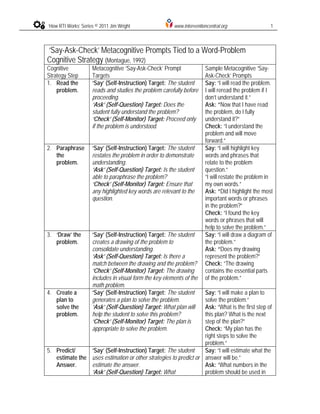Weitere ähnliche Inhalte
Ähnlich wie Math meta cog_strategy_montague_say_ask_check
Ähnlich wie Math meta cog_strategy_montague_say_ask_check (20)
Math meta cog_strategy_montague_say_ask_check
- 1. ‘How RTI Works’ Series © 2011 Jim Wright www.interventioncentral.org 1
‘Say-Ask-Check’ Metacognitive Prompts Tied to a Word-Problem
Cognitive Strategy (Montague, 1992)
Cognitive
Metacognitive ‘Say-Ask-Check’ Prompt
Strategy Step
Targets
Sample Metacognitive ‘Say-
Ask-Check’ Prompts
1. Read the
problem.
‘Say’ (Self-Instruction) Target: The student
reads and studies the problem carefully before
proceeding.
‘Ask’ (Self-Question) Target: Does the
student fully understand the problem?
‘Check’ (Self-Monitor) Target: Proceed only
if the problem is understood.
Say: “I will read the problem.
I will reread the problem if I
don’t understand it.”
Ask: “Now that I have read
the problem, do I fully
understand it?”
Check: “I understand the
problem and will move
forward.”
2. Paraphrase
the
problem.
‘Say’ (Self-Instruction) Target: The student
restates the problem in order to demonstrate
understanding.
‘Ask’ (Self-Question) Target: Is the student
able to paraphrase the problem?
‘Check’ (Self-Monitor) Target: Ensure that
any highlighted key words are relevant to the
question.
Say: “I will highlight key
words and phrases that
relate to the problem
question.”
“I will restate the problem in
my own words.”
Ask: “Did I highlight the most
important words or phrases
in the problem?”
Check: “I found the key
words or phrases that will
help to solve the problem.”
3. ‘Draw’ the
problem.
‘Say’ (Self-Instruction) Target: The student
creates a drawing of the problem to
consolidate understanding.
‘Ask’ (Self-Question) Target: Is there a
match between the drawing and the problem?
‘Check’ (Self-Monitor) Target: The drawing
includes in visual form the key elements of the
math problem.
Say: “I will draw a diagram of
the problem.”
Ask: “Does my drawing
represent the problem?”
Check: “The drawing
contains the essential parts
of the problem.”
4. Create a
plan to
solve the
problem.
‘Say’ (Self-Instruction) Target: The student
generates a plan to solve the problem.
‘Ask’ (Self-Question) Target: What plan will
help the student to solve this problem?
‘Check’ (Self-Monitor) Target: The plan is
appropriate to solve the problem.
Say: “I will make a plan to
solve the problem.”
Ask: “What is the first step of
this plan? What is the next
step of the plan?”
Check: “My plan has the
right steps to solve the
problem.”
5. Predict/
estimate the
Answer.
‘Say’ (Self-Instruction) Target: The student
uses estimation or other strategies to predict or
estimate the answer.
‘Ask’ (Self-Question) Target: What
Say: “I will estimate what the
answer will be.”
Ask: “What numbers in the
problem should be used in
- 2. ‘How RTI Works’ Series © 2011 Jim Wright www.interventioncentral.org 2
estimating technique will the student use to
predict the answer?
‘Check’ (Self-Monitor) Target: The
predicted/estimated answer used all of the
essential problem information.
my estimation?”
Check: “I did not skip any
important information in my
estimation.”
6. Compute
the answer.
‘Say’ (Self-Instruction) Target: The student
follows the plan to compute the solution to the
problem.
‘Ask’ (Self-Question) Target: Does the
answer agree with the estimate?
‘Check’ (Self-Monitor) Target: The steps in
the plan were followed and the operations
completed in the correct order.
Say: “I will compute the
answer to the problem.”
Ask: “Does my answer
sound right?” “Is my answer
close to my estimate?”
Check: “I carried out all of
the operations in the correct
order to solve this problem.”
7. Check the
answer.
‘Say’ (Self-Instruction) Target: The student
reviews the computation steps to verify the
answer.
‘Ask’ (Self-Question) Target: Did the student
check all the steps in solving the problem and
are all computations correct?
‘Check’ (Self-Monitor) Target: The problem
solution appears to have been done correctly.
Say: “I will check the steps of
my answer.”
Ask: “Did I go through each
step in my answer and check
my work?”
Check: “”
Reference
Montague, M. (1992). The effects of cognitive and metacognitive strategy instruction on the mathematical problem
solving of middle school students with learning disabilities. Journal of Learning Disabilities, 25, 230-248.
